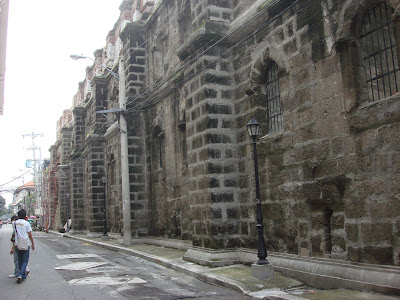After 22 ½ hours either sitting in an airplane or at an airport, I made it to Manila and checked into my hotel around Midnight. Got about five hours sleep and woke up around 6:00 this morning, ate a good breakfast at the hotel and headed out on foot this morning to try and wear myself out so I can sleep tonight and overcome jetlag as soon as possible.
 The hotel is really five-star and about two blocks from Manila Bay—in fact, this is the sight that I got out my window first thing this morning. Actually the walk along the sidewalk facing the bay looks a lot nicer on the maps than it really is. I did walk along the coast past the U.S. Embassy where I’ll be working tomorrow and crossed over into the Rizal Park—the central landmark and recreational area in Manila. The name “Rizal” is etched literally everywhere in this city. Dr. Jose Rizal was a medical doctor who was executed by the Spanish in 1896 for leading a movement to overthrow the Spanish colonial government and establish an independent Philippines. He was imprisoned in the old Fort Santiago near here and marched to this park and shot by a firing squad. He is a national martyr here—even the path he
The hotel is really five-star and about two blocks from Manila Bay—in fact, this is the sight that I got out my window first thing this morning. Actually the walk along the sidewalk facing the bay looks a lot nicer on the maps than it really is. I did walk along the coast past the U.S. Embassy where I’ll be working tomorrow and crossed over into the Rizal Park—the central landmark and recreational area in Manila. The name “Rizal” is etched literally everywhere in this city. Dr. Jose Rizal was a medical doctor who was executed by the Spanish in 1896 for leading a movement to overthrow the Spanish colonial government and establish an independent Philippines. He was imprisoned in the old Fort Santiago near here and marched to this park and shot by a firing squad. He is a national martyr here—even the path he  walked to this site is memorialized with brass footprints. The execution site and memorial is pretty amazing—larger than life figures play out the scenes leading to and
walked to this site is memorialized with brass footprints. The execution site and memorial is pretty amazing—larger than life figures play out the scenes leading to and including his execution. I am posting a couple of similar photos to show the size of these figurines.
including his execution. I am posting a couple of similar photos to show the size of these figurines. I spent some time walking around the park—the humidity was oppressive even by Houston standards as early as 9:00 this morning and my clothes were literally saturated with sweat. I checked out some Chinese and Japanese gardens and some of the hundreds of statues and memorials around the park.
I then continued on to Intramoros, which is the old walled city inside Manila. The Spanish started building it in 1571 and originally it was a walled fortress protecting Spanish citizens and the interests of the king of Spain. Inside were a number of colonial mercantile offices, churches, convents, schools and housing for the privileged Spanish—all, of course, to the exclusion of the Chinese, Muslims, and Filipinos. Over the years it was invaded by Chinese pirates, threatened by Dutch forces, and held by the British, Americans and Japanese at various times and survived until the closing days of World War II when the U.S. basically bombed it out of existence during the Battle of Manila. I took a thirty-minute horse and buggy tour around what is left of the walls—not that great of tour—and then spent considerable time inside the old Fort Santiago, which is part of Intramoros and protected the coast overlooking Manila Bay and the entrance to the Pasig river. Today 
Walked back to the hotel and am really exhausted—the jet lag is getting to me. I’m going to spend the afternoon at the hotel and try not to nap so I can get back on regular schedule before I start work tomorrow. So far all is going well and I like it here. It is very similar to Thailand but so far not as open and clean.
The photo at the bottom of this post is a picture of the famous, or infamous, Filipino "Jeepneys." They were originally built after World War II as taxis made from old U.S. army jeeps and have evolved into a art form. They are very cheap forms of public busses and are still today basically fashioned from old auto parts. They have "Mercedes" and "Toyota" and everything else painted on them but they are basically custom built taxis.




No comments:
Post a Comment